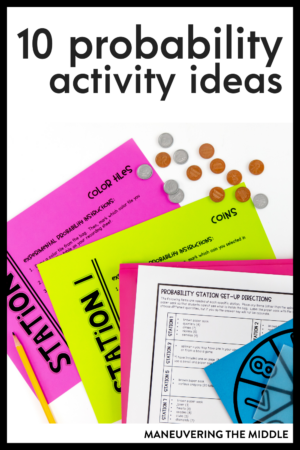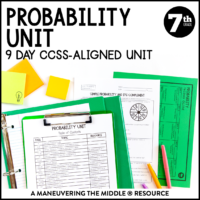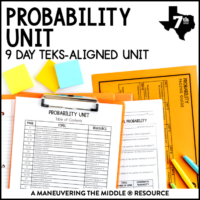As promised, I have returned to present Probability activities I found after scouring the internet. To make this list, the activity had to be straightforward, engaging for students, and have good value. Also, Maneuvering the Middle resources will be on this list because I have used and loved them!
Helpful Tools to Support Activities
Before we jump into activities, you will want to be prepared with the right manipulatives. Here are my recommendations.
- Foam dice are the only number cubes you should consider. This set has 36 which is enough for every student to have one.
- Paper bags – I would just grab these at the grocery store, but there is a link for your convenience. There will be lots of drawing items from bags, so be prepared!
- Spinners – You just need a pencil and a paperclip to make a spinner. No need to purchase spinners!
- Online Probability Generator – This online tool allows students to simulate drawing objects, flipping dice, and pulling things out of a bag.
- Unifix Cubes – I will elaborate below.
Experimental vs. Theoretical Probability
1. Theoretical and Experimental Probability Stations Activity – This Station activity has 8 stations where students can practice experimental probability by drawing tiles/cards/counters/letters from a bag, spinning a spinner, and rolling a number cube. Students will calculate the theoretical probability and participate in experimental probability by repeating the experiment 20 or so times. The recording sheet makes this activity easy breezy to implement.

Bonus points for collecting the information from the entire class and comparing the difference of their individual results to the collected data of the whole class or the entire grade.
Note: You don’t need to purchase this activity to have your students do something similar.
Simple Probability
2. Greedy Pig – This activity was mentioned in our Facebook Group as a game that is great to introduce simple probability. Here is the gist of the rules:
- Students (in smaller groups) take turns rolling a 6-sided foam die.
- Each round consists of a student rolling the die until they decide to stop or roll a 1.
- When you are rolling, your score is the sum of all of the numbers you rolled on that turn.
- If and when you roll a 1, your score goes to 0. The player with the highest score after X amount of rounds, wins the game.
After students play a few games, you can ask students: when did you decide to stop rolling? What strategies did you employ to avoid rolling a 1? Do your chances of rolling a 1 increase after each roll? You can read more about this game over at Math = Love.
3. Squid Game: Dice Game – Show students this clip from Squid Games: The Challenge. (Don’t worry – this isn’t violent; it is from the reality show). Players have to nominate a player (or themselves) for elimination. If they rolled a 6, that player was eliminated. Any other number resulted in no player eliminated. You can ask students: how many rounds would be needed to eliminate 2 players? You could also simulate this activity in groups with your students.
Compound Probability
4. Squid Game: Glass Bridge Problem – This is actually a great probability problem! And honestly, a perfect example of compound probability. Here is a clip of the show for context
The game involves players attempting to cross two parallel bridges by jumping across tempered glass panels while avoiding weaker panels of regular glass. Those who landed on a regular glass panel broke through the panel and were eliminated. You can ask questions like: What is the probability a single contestant in the very front can make it across the 18 panels successfully? How did the players taking turns jumping onto the next panel increase the chances of staying in the game for the players in the front?
This is an activity that I would DEFINITELY have students play! I would use painter’s tape to create panels in the hallway, preemptively decide which panels were safe, and have students draw numbers to decide what order they would attempt the bridge. This is the type of activity that gets talked about at lunch and in other classes.
(In all transparency, this problem is a little beyond middle school math since a player’s chances are impacted by how well the person in front of them did, but I think you can focus on the chances of the person currently in the front making it to the end successfully based on the number of panels they have remaining.)
5. Guess Your Phone Number – On one commute home, I was listening to NPR’s This American Life as they were discussing coincidences. The narrator tells the craziest coincidence I have ever heard. He was walking along in the mall when someone who was obviously trying to sell him something approached and made his pitch. Feeling uncomfortable, the narrator provides a fake name and a fake phone number in an attempt to escape. The salesperson says, “There is no way that is your phone number!” The storyteller doubles down, “Sure it is!” The salesperson exclaims, “That cannot be your phone number because that is MY phone number.”
After telling my students this story, I asked students to calculate (or write the expression) that would represent the probability of guessing someone’s phone number correctly. This is a perfect warm-up or wrap-up to the class.
Dependent Probability
6. Egg Roulette – Of course a video is worth a million words, so here is a clip from The Tonight Show with Jimmy Fallon. If you want to go all out, purchase some ponchos and have 2 of your students participate in a live demonstration. Have students calculate the probability of choosing a raw egg after each turn.
7. Bean Boozled – This is another great activity from a teacher in our Facebook Group. Place X amount of fruity jelly beans and X amount of gross jelly beans in a bag. As a class, have students taking turns removing a jelly bean and eating it. After each round, have students work together to calculate the probability of picking a fruity or gross jelly bean on the next turn. Next student picks and so on. You can then facilitate conversations about why the denominator and numerator will change depending on what has already been drawn.
Sample Space
8. Unifix cubes – We are all probably familiar with using tree diagrams to model sample space. However, this idea from another teacher in our Facebook Group is genius. Use unifix cubes to show all the variations that can occur. This works best for outfits (green unifix cube as a shirt, blue unifix cube as pants) and for food items.
9. Probability Units – If you want all of the probability lesson planning, student notes, study guide, and assessment to be done for you, then may I suggest our Probability Units in both CCSS and TEKS? The units cover simple probability, sample space, experimental and theoretical probability, simulations and predictions, and independent and dependent events.
10. Probability Activity Bundle – Lastly, I recommend our Probability Activity Bundle. Here is what it includes:
- Simple Probability Maze
- Simple Events Error Analysis
- Experimental vs. Theoretical Probability Stations
- Making Predictions Puzzle
- Independent Probability Error Analysis
- Dependent Probability Cut and Paste
- Unit Overview Task Cards
I love having all of my activities printed and prepped ready for the unit! This bundle makes that doable!
One last thing – Deal or No Deal would be a fun addition to your Probability unit! I can see it being an incentive for the end of each class period for the length of the probability unit.
What are your favorite probability activities?








